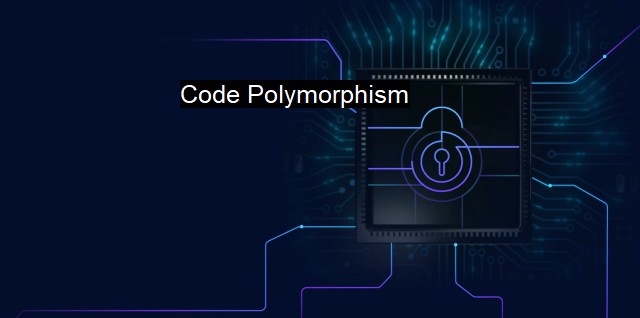What is Code Polymorphism?
Code Polymorphism: A Key Technique for Evading Detection in Cybersecurity
Code polymorphism is a concept in computer science that refers to the ability of different objects and data types to be processed in the same way. This is possible through the use of a single interface, shared by different underlying forms or types. The term ‘polymorphism’ is derived from Greek where 'poly' signifies 'multiple' and 'morphism' refers to 'forms.' In the context of software programming, polymorphism is regarded as an essential feature of Object-Oriented Programming (OOP), providing greater flexibility and optimization to the programming processes. when this concept is applied for harmful intentions such as launching cyber attacks, it becomes a menace for cybersecurity experts.In the prism of cybersecurity, code polymorphism takes a more nefarious interpretation. Pirates tend to use polymorphism as a tool to mutate their malicious codes or software, to bypass the defense mechanisms of security software like antiviruses. Polymorphic codes are designed to change their identifiable features such as name, size or metadata each time they are run, making detection almost impossible. Once they have infected a system, they can contort their appearance to make their detection, isolation and removal incredibly challenging. This threat is aggravating with the increasing use of polymorphic malware which has become a go-to tactic for black-hat hackers.
Most conventional virus scanners rely on virus signatures or hash for their detection activities. These signatures are unique for each virus and remain consistent across all infections. Polymorphic codes are designed to change their signature after each execution, thus becoming invisible to the traditional virus scanners.
Another major challenge for antivirus software is polymorphic shellcodes. Shellcodes constitute the payload in a malware attack and typically possess definite formats. Polymorphic shellcodes alter this predetermined format to bypass security measures and infiltrate the systems.
To effectively combat the threat of polymorphic malware, cybersecurity experts have incorporated the technique of 'heuristic analysis' in antivirus software. Heuristic analysis investigates the potential behavior of the code, rather than simply matching patterns. It employs algorithms which can detect hitherto unknown or modified forms of malware. The employment of machine learning and artificial intelligence has also shown significant promise in combating the threat of code polymorphism and polymorphic malware.
Further, cybersecurity defense mechanisms are increasingly adopting a cloud-based approach, which has shown greater efficacies in countering polymorphic threats. Such cloud-based antiviruses operate by collecting data from various sources, analyzing them in real-time and alerting the system about potential threats even in their modified attire.
Another focus area in combating polymorphic threats could be enhancing root-cause identification and patch management. Patch management ensures rectification or mending of any loopholes in the software, preventing the chance of any successful exploitation of vulnerability.
Code polymorphism serves as a double-edged sword in the realm of computer science and cybersecurity. On the one hand, if it's used constructively, it provides great possibilities for flexibility and optimization in programming. On the other hand, it poses considerable challenges for cybersecurity establishments worldwide due to its inherent ability to mutate and camouflage itself from the prying eyes of security software. The continual advancements in machine learning, artificial intelligence, and cloud-based cybersecurity solutions provide hope in our enduring battle with polymorphic threats. more in-depth research and strategic collaborations will be required for winning this cyber tug of war.

Code Polymorphism FAQs
What is code polymorphism in cybersecurity?
Code polymorphism is a method used by cybercriminals to obfuscate malicious code by constantly changing its appearance without affecting its functionality. This technique makes it harder for antivirus software to detect and block the malicious code.How does code polymorphism work?
Code polymorphism works by changing the structure and behavior of the malware on the fly, making it harder for antivirus software to recognize and block it. This can be achieved through various methods, such as encryption, obfuscation, and using different algorithms to achieve the same outcome.How can antivirus programs detect and prevent code polymorphism?
Antivirus programs use different techniques to detect and prevent code polymorphism, such as signature-based detection, heuristic analysis, and behavioral analysis. Signature-based detection works by looking for specific patterns in the code that match known malware signatures. Heuristic analysis looks for suspicious behavior or characteristics of the code, while behavioral analysis monitors the behavior of the code in a controlled environment to detect suspicious activities.Can code polymorphism be used for legitimate purposes?
Yes, code polymorphism can be used for legitimate purposes, such as improving software security and protecting intellectual property. It can be used to protect software code from reverse engineering and unauthorized access by constantly changing its appearance and behavior to make it harder to understand and modify. Code polymorphism can also be used to protect sensitive data by encrypting it with constantly changing keys.| | A | | | B | | | C | | | D | | | E | | | F | | | G | | | H | | | I | | | J | | | K | | | L | | | M | |
| | N | | | O | | | P | | | Q | | | R | | | S | | | T | | | U | | | V | | | W | | | X | | | Y | | | Z | |
| | 1 | | | 2 | | | 3 | | | 4 | | | 7 | | | 8 | | |||||||